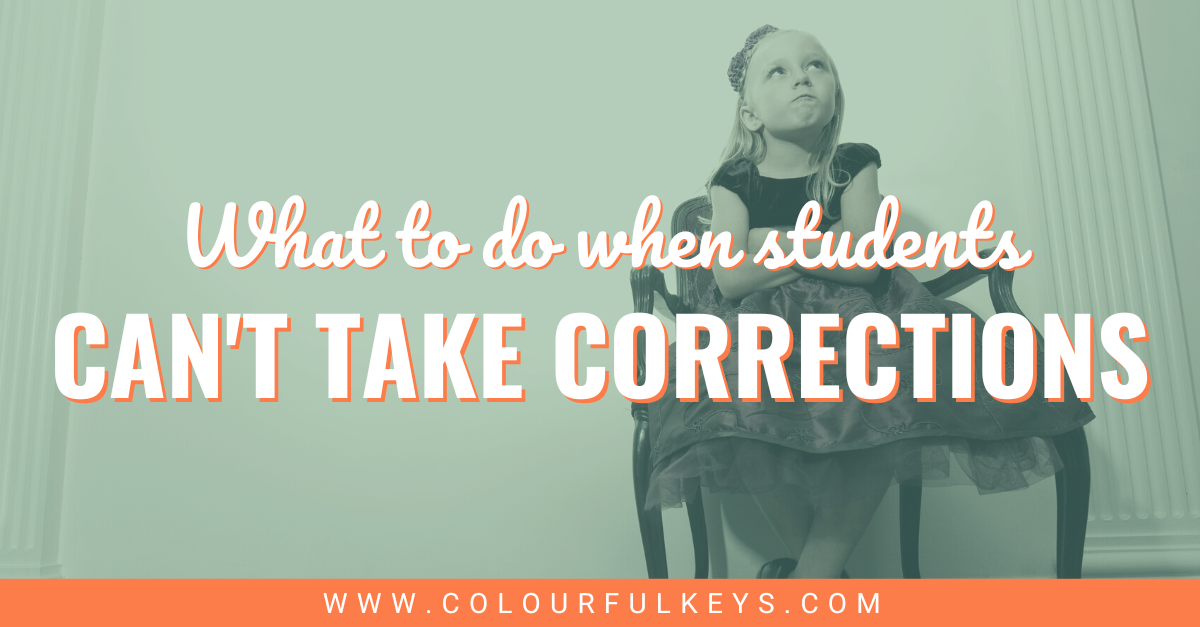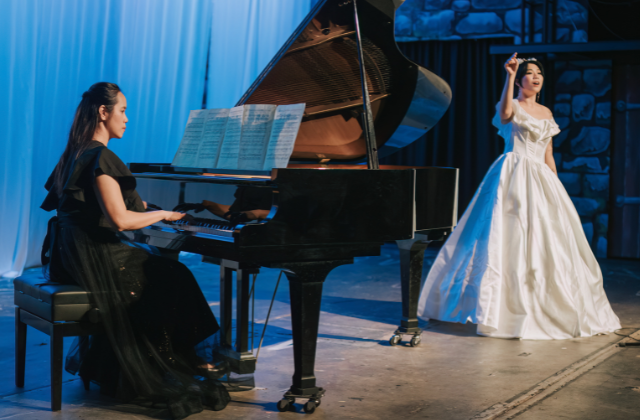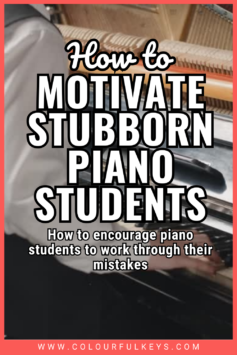
This blog post about giving feedback to a stubborn piano student was written by Carmen Carpenter. Carmen has taught music in a school setting as well as in her home studio for 30 years. Teaching combines two of her favourite things: music and kids! Besides teaching music, Carmen loves spending time with family playing games, working puzzles and watching movies. She is also an avid reader and loves taking long walks on her local, woodsy trails.
Have you ever had a RESISTANT student? I’m not talking about a student who is resistant to practising. (I’m certain we’ve all had that student.🙄) No, I’m referring to the student who just can’t deal with teacher correction of their playing.

When faced with a defiant piano student, you may feel like the bad guy. But most students instinctively know a teacher’s literal job is to give feedback which will help them learn and grow.
In fact, many students actually crave corrective feedback!
But others really struggle to know how to receive corrections or instructions, using them to get better and, ultimately, keep going.
When a student shuts down, it can stall or even stop their piano progress altogether.
So what’s a teacher to do when a student becomes resistant?
Step 0: Prepare for Resistance
Remember your students are humans. And humans make mistakes. The best thing you can do to deal with resistance from a stubborn piano student is to be prepared for its eventuality.
Put the following in your teacher toolbelt so you’ll be ready the next time you deal with a student who can’t take corrections.
Step 1: Understand Resistance
If we’re going to address resistance, we need to understand it in the first place.
What does this pushback look like?
Resistance can take obvious forms like excuses, explanations, arguing, crying and shutting down. But stubbornness can also be sly, wily and tricky – so be on the lookout for some of these more passive-aggressive forms of resistance:
- Appearing to agree with your suggestions, then doing nothing about them during home practice.
- Making mistakes on purpose to “show you” your instructions are just too much or too far.
- Going silent or engaging very little in dialogue about feedback.
If you can quickly recognize these passive forms of resistance, you can stop them before they become a pattern.
Why does resistance happen?
Generally speaking, students are not trying to be contrary. There’s usually a deeper reason behind their lack of cooperation. Consider the following possibilities:
Fear and/or Anxiety
Fear of failure, of making mistakes or of disappointing others can drive some students to be uncooperative.
I think many teachers would agree that students today, in general, are much more anxious and fearful than they were in years past. The world is full of critics and it can be hard for students to accept feedback from you – someone they care about and look up to.
Overwhelm
Learning to play an instrument is hard. There’s note reading and keyboard geography and rhythm and steady beat and tempo and dynamics and technique and…you get the picture.
That’s a lot for an adult to handle, much less a young person!
Disinterest
Some students are taking music lessons just because their parents make them.

And other students may like piano just fine, but on a given day and time they may just prefer to be somewhere else. (At the pool on a sunny day, anyone? 🏖️)
Lack of Preparation
When a student hasn’t practised – and they know it – they might not take kindly to your teacherly efforts to try and help them play better.
If practice tends to be a chronic problem in your studio, you’ll love the resources on Nicola’s “Teaching Piano Practice” hub page.
Closed Mindset
Maybe you’re familiar with closed mindset vs. growth mindset because you read the book ‘Mindset‘ by Carol S. Dweck, or maybe you’re familiar with the concept from somewhere else.
When a student has a closed mindset, they often resist attempts to help them improve because they truly believe they’ll never be able to play that exercise or piece – no matter how hard they try.
Are you a member of Vibrant Music Teaching? If so, try these fantastic tools for working on a growth-orientated mindset.
Step 2: Create a Safe Space for Imperfection
One of the first ways to tackle resistance from a stubborn piano student is to try and head it off at the pass. You’ll notice less resistance, in general, if you create a lesson environment that embraces mistakes and failure.
How can we do that?
Shrug Off Your Own Mistakes
I assume since you’re human, your playing is not mistake-free. But consider your reactions in situations like these:
- When you play wrong notes, do you get embarrassed or flustered and apologise for the mistake?
- Do you make excuses or try to explain why you messed up?
- If a student corrects you when you make a mistake, how do you react?
When you mess up and react by apologising, making excuses or getting defensive, students will pick up on that vibe and employ those reactions themselves.
But…
If your students see you make mistakes, giving little or no attention to the errors, they’ll sense your studio is a safe space for mistakes, leading to better acceptance of critique in general.
Encourage Mistake Recovery
Even though most of us know this, if you’re like me, you still tend to stop or interrupt students when they make a mistake. And, of course, students tend to stop themselves when they make mistakes.
Remind students that the musicians they see live on television or at concerts are not always (if ever!) mistake-free. Those performers have learnt to play or sing through mistakes, acting as though the music was meant to be like that in the first place.

You could even go one step further and watch some videos where artists have flubbed, and discuss together how they recovered.
Encourage your students to play through their errors as if they absolutely meant to play that way because it’s likely no one would even notice their mistake.
Gamifying this process makes it a lot more fun than just nagging students to keep on playing when they mess up.
Celebrate Mistakes
Let students know that making mistakes in lessons is a good thing. If students don’t make mistakes, they don’t learn anything new or improve in other areas.
These errors also give the teacher the needed information to help them get better.
Unicorn Horncraft is a fabulous resource from the Vibrant Music Teaching membership which helps students practise making mistakes…my students ♥️ this game! Enter your info below and Nicola will send a free copy of the game straight to your inbox.

Subscribe to the newsletter and get unicorn horncraft
Enter your details to subscribe to the newsletter for piano teachers with information, tips and offers.
I hate spam as much as you do! I will only send you emails related directly to piano teaching and you can unsubscribe at any time.
These free resources are just the tippy top of a very huge VMT iceberg. If you haven’t heard of the membership, or don’t know much about it, take a tour today.
Provide Choices
Students who feel they have some level of control in lessons tend to be more open to feedback in general.
Give students small either/or choices, such as:
- Which piece would you like to play first?
- Do you want to play this game now, or after the next exercise?
- Should we do scales or rhythm next?
Choices like these won’t wreck your overall lesson plan, but they will give students the impression that what they have to say matters to you.
Make Things Feel Easy
Setting up students for success is another way to discourage resistance in a stubborn piano student, because they won’t feel the end goal is out of their reach.
- Ensure your students are fluent with note reading and rhythm by playing lots of games.
- Sight read several levels below their current ability.
- Chunk their pieces into more manageable bits for home practice, even if it means their progress is a little slower. (Lasagne and Layers and Parfait Practice from the VMT Printable Library are great resources to make the chunking fun and purposeful.)
Kids are human too!
They will mess up and they will get their feathers ruffled when someone points it out. Have a little empathy for their human condition, please.

Remember, you’re the adult in this situation and you can help guide them to work on those feelings in a healthy way.
Step No. 3: Address Resistance
Occasionally, even if you’ve created the safest possible “mistakes are OK” environment, you’ll face a particularly stubborn piano student and resistance is going to happen.
Acute Aversions
When a usually-compliant, easy-to-teach student suddenly appears reluctant, try one of these tips:
Encourage Ownership
Sometimes a student finds your feedback disagreeable because they honestly don’t hear their mistakes. Guide them toward identifying their own errors in one of these ways:
- Have them listen while you play the way they played. Then play the correct way. Ask them to spot the difference between the two versions.
- Play with them in unison. (This is especially helpful when a student is struggling with rhythm.)
- Use a stuffed toy to nag them about their mistakes. Try using a funny, stern voice to lighten the moment. In this way, the toy is the bad guy instead of you.
- Record them playing, and ask if they can spot the “oops” in the video playback.
Hopefully, these tricks will create an “aha” moment and inspire your student to self-correct.
Talk It Out
Check in to make sure everything is okay. Say to them, “I’ve never seen you so out-of-sorts; is everything OK?” It may be the student just had a bad day at school and you’re simply the one getting the brunt of their emotions.
Take a Break
Sometimes students get overwhelmed by all the stuff that goes into learning piano. Taking a short break can relieve stress for the student – and you.
- Use the Silliness Siestas cards from the VMT Printable Library to provide an active 1 – 2 min. break.
- Focus on something other than the issue at hand, but keep things learning-centred.
- Have the student count all the semibreves (whole notes) in their piece.
- Ask them to point to and name every musical symbol in the piece.
- Do a quick flashcard drill (one that’s unrelated to the issue causing resistance).
- Tell them to think of a little story or situation their piece may be describing.
Even just 60 seconds of doing something else can help you conquer the overwhelm.
Share Your Own Feelings
Did you know it is totally OK to tell a student they are hurting your feelings? Sometimes kids forget the adults in their lives have feelings, too.
If a student is being rude or disrespectful, calmly tell them you are hurt by their behaviour. It may be they don’t realise how difficult they’re actually being.
When you share your feelings, your difficult student’s defiance may simply melt away, clearing the air for a dialogue about your corrections.
Chronic Confrontation
It is rare, but you will sometimes have a student who is regularly reluctant. When (or hopefully, if🤞) this happens, you simply must contact their parent to discuss their child’s behaviour. And, no, an email will not suffice. A phone call, or even an in-person meeting, is required.
Be Honest
Tell the parent frankly and directly about the behaviours you’ve been seeing.
Ask
Find out if they’ve noticed this problem before. Ask them how they dealt with the issue.
Brainstorm
Discuss ways you can work together on this problem.
And if all else fails…
Now and then (thankfully rarely!) you’ll find you just can’t win over a truly stubborn or defiant piano student. That’s when it’s better for you – and all the other people in your life – if you respectfully ask them to find another piano teacher.

What do you do when faced with a stubborn piano student?
In the comments below, we’d love to hear your ideas on dealing with students who are resistant to feedback. 🙂
